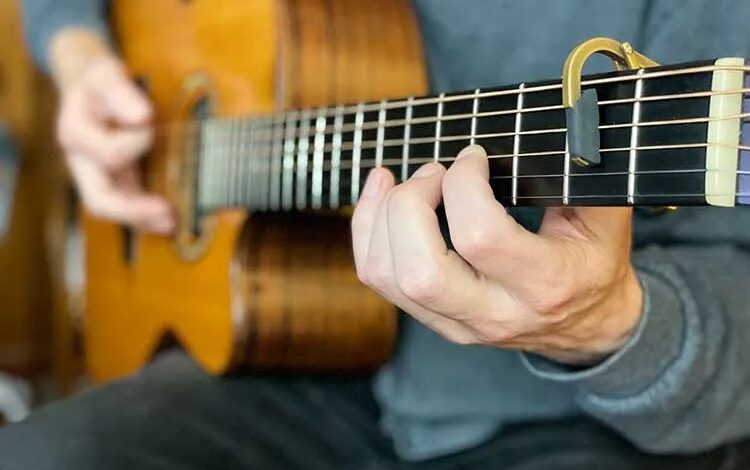Unlock New Sounds with a Partial Capo

A partial capo performs a kind of magic trick on your guitar. Fool your friends and baffle your enemies: you sound like you’re using an alternate tuning, but you’re not!
Partial capos accomplish this sleight of hand by holding down some strings and leaving others untouched—thereby changing the intervals between open strings.
In an earlier lesson (published in the May 2017 issue and in the book/video Beyond Strumming), I introduced the five-string partial capo, which gives you a setup similar to dropped-D tuning if you place the capo at the second fret covering the top five strings. Now let’s explore the three-string capo, designed to hold down strings 3–5 or, flipped around to the other side of the fingerboard, strings 2–4.
The most common use of a three-string capo is on strings 3–5 at the second fret—the capo is grabbing an Esus4 chord shape for you. (Look ma, no fretting!) In that position, the intervals between open strings are the same as in DADGAD tuning up a whole step (E B E A B E). So the capo gives you something like instant DADGAD, while your strings are physically still in standard tuning.
In this workout, we’ll focus mostly on this DADGAD (or Esus) partial capo position—looking at chord shapes and then trying them out in short progressions. In Week Four, we will flip the capo around to cover strings 2–4 at the second fret—so it’s holding down an A major chord shape.
Unless you want to attempt cutting up a regular capo—not an easy or recommended hack—you’ll need a special capo to play these examples. Fortunately, three-string capos are readily available and not a big investment: check out the Shubb C7B, Kyser Quick-Change Short Cut, D’Addario Artist DADGAD, G7th Newport three-string model, and others. And the cost is well worth it for cracking open a whole new candy box of sounds on your guitar.
Week One: Familiar Shapes, New Sounds
First, put your partial capo in place on strings 3–5 at the second fret. Strum across the open strings to hear the sus4 chord. You may need to tweak your tuning after adding the capo; I find that a partial capo tends to knock out the tuning a bit.
Now check out the D chord shapes in Example 1, starting with the one-finger D5. Note that I’m naming chord shapes in relation to the capo; a D shape sounds as an E. Also note that the top line of these chord grids represents the capo position (second fret). When strings 6, 2, or 1 are open, they actually ring two frets below the capo, at the nut.
Try out the D major, D minor, and D7 shapes, all with lots of open strings. The Dadd4 is a sweet cluster voicing with the third and fourth of the chord next to each other.
Play some G voicings in Example 2. You’ll notice that the first G shape looks and sounds just like you’re in standard tuning—because you are in standard tuning! In the second G shape, leave the first string open. Then open up the second string, too, for a Gadd9. As shown, you can also play a Gadd9 by using the third-fret barre chord shape but leaving the top strings open; the example shows variations fretted with four, three, and two fingers. Finally, check out the Gm shape that’s far gentler on the fingers than the usual six-string barre.
Example 3 offers a selection of A major and minor shapes enriched with sus4, add4, and 11 extensions on the open first and second strings. In the last few A shapes, move up the neck while still using open strings on top.
In Example 4, play through more chord shapes, starting with Cadd9 and C9. The E chords present a wrinkle: if you want a low root, you have to fret the sixth string alongside the capo. To accomplish that, you may need to scoot your capo a little further from the second fret (toward the nut) than you would normally place it; look for a sweet spot just far enough from the fret that your index finger can slip in to fret the sixth string, but not so far that it causes the capoed strings to buzz or sound dull. Fretting beside the capo like this may feel awkward at first but gets more comfortable with practice.
Closing out this week, play the Bm7, F6, and Bbmaj7 shapes, all with sparkly open strings on top. Bear in mind that you can transpose all these chord shapes (and the examples that follow) with a regular capo: just use a regular capo plus a partial capo two frets higher. If you put a regular capo at, say, the third fret, and the partial capo at the fifth fret, your D shapes sound in the key of G.
Beginners’ Tip #1
Remember that the partial capo only affects the sound when you’re playing an un-capoed string open.

That’s the end of week one. The complete lesson features four weeks of workouts (plus a bonus exercise.) There are two ways to access the full video and musical examples: Join our community at Patreon.com/acousticguitarplus OR Buy the January-February 2024 issue of Acoustic Guitar magazine.



